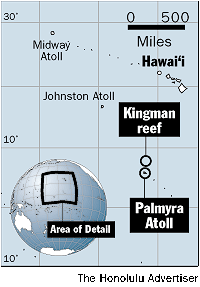By Jan TenBruggencate
Advertiser Science Writer
The U.S. Fish and Wildlife Service has established two new mid-Pacific National Wildlife Refuges, over the objection of the Honolulu family that claims ownership of one of them.
The service yesterday announced that it has taken title from the U.S. Department of the Interior’s Office of Insular Affairs of Palmyra Atoll and nearby Kingman Reef in the Line Islands, about 1,000 miles south of Honolulu.
"I am pleased that these magnificent underwater coral gardens will now get the protection they richly deserve," said Secretary of the Interior Bruce Babbitt, in an announcement just two days before the Clinton administration leaves office.
But the agent for Honolulu’s Fullard-Leo family said the clan will fight in court for what it believes it owns.
The family last year sold Palmyra to The Nature Conservancy, but retained title to Kingman Reef, said Realtor Peter Savio.
"It’s a land grab,’’ he said. "The Fullard-Leos own Kingman Reef. The Fullard-Leos have owned Kingman Reef since the 1920s. The Fullard-Leos have paid property taxes on Kingman Reef."
The family laid claim to the unattached sand spits and lagoon in 1922, and annexed it to the United States, he said. Both Palmyra and Kingman Reef had the same Honolulu property tax map key, and the family paid the taxes until the islands were left out of the state of Hawaii boundaries at statehood in 1959.
"We only hope that the next administration will correct this," Savio said. Otherwise, "there’s going to be a legal battle."
Barbara Maxfield, Honolulu representative of the Fish and Wildlife Service, said the agency has talked with the Fullard-Leos, but feels it is on solid ground.
"The Fish and Wildlife Service, the Navy before that and the General Accounting Office all said it was the Navy’s" before it was transferred to the service, she said.
Both Palmyra and Kingman, which are less than 40 miles apart, include wide regions of reef and bits of land that provide nesting
areas for turtles and seabirds. Kingman has three acres of dry land in the form of three small unvegetated sand bars, while Palmyra has dense stands of tropical forest.
The Nature Conservancy bought the 680 acres of dry land at Palmyra from the Fullard-Leos, and hopes to sell all but the main island to the Fish and Wildlife Service.
The boundaries of the new wildlife refuges include all dry land, reefs and waters within 12 nautical miles of shore at both locations. Kingman Reef National Wildlife Refuge covers an estimated 483,700 acres of water, including 25,874 acres of coral reef habitat.
"This refuge will protect a spectacular diversity of coral reef fishes, corals and other marine organisms, as well as provide habitat for migratory seabirds and shorebirds and threatened green sea turtles," said Anne Badgley, the service’s Pacific regional director.
Palmyra Atoll National Wildlife Refuge has 515,232 acres of water with 16,000 acres of coral reef habitat. The land areas form the world’s second-largest nesting area for the red-footed booby and is the part-time home to many other seabirds, including an estimated 750,000 sooty terns.
[back to top] |

